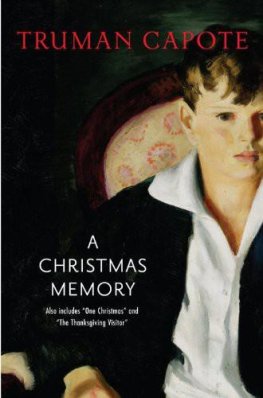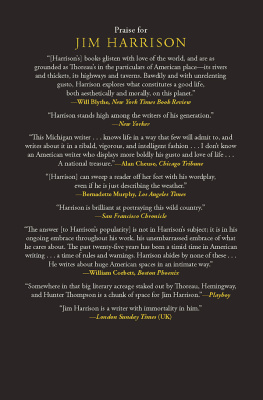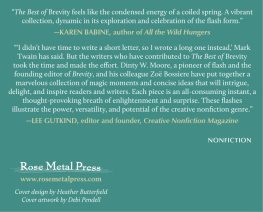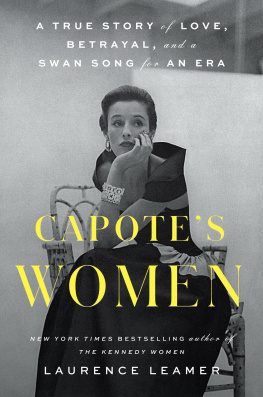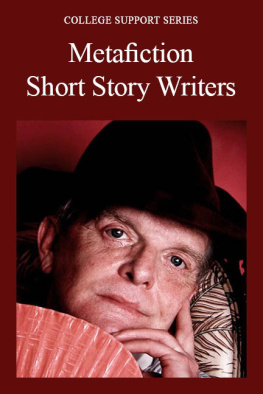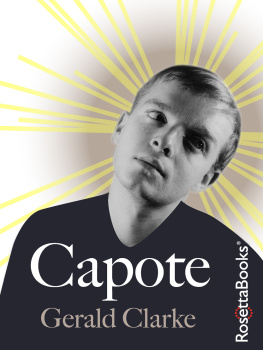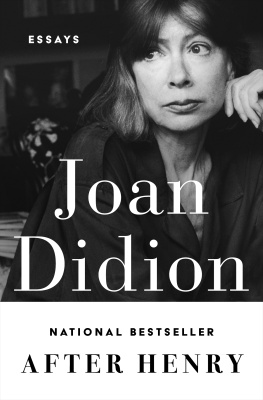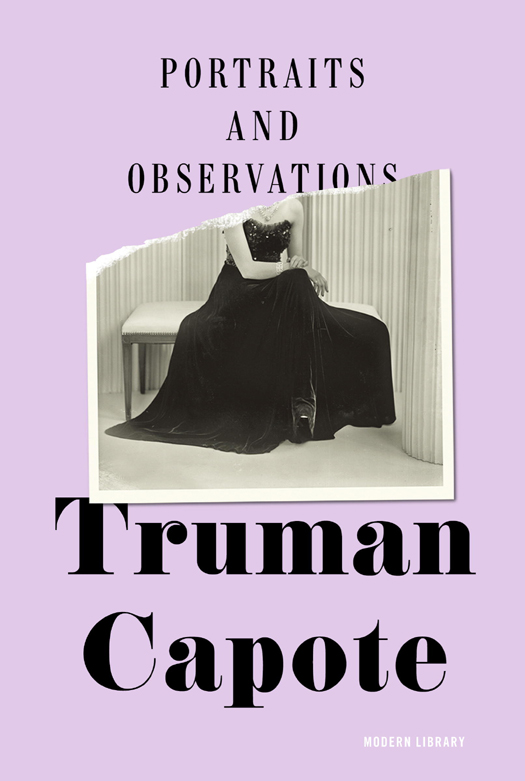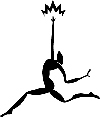2013 Modern Library Edition
Copyright 2007 by Truman Capote Literary Trust
Biographical note copyright 1993 Random House, Inc.
All rights reserved.
Published in the United States by Modern Library, an imprint of The Random House Publishing Group, a division of Random House, Inc., New York.
M ODERN L IBRARY and the T ORCHBEARER Design are registered trademarks of Random House, Inc.
Elizabeth Taylor was originally published in Ladies Home Journal, December 1974 issue. Extreme Magic was originally published in Vogue, April 1967 issue. Remembering Tennessee was originally published in Playboy magazine, January 1984 issue. Music for Chameleons, The Muses Are Heard (originally titled Porgy and Bess in Russia), and The Duke in His Domain were originally published in The New Yorker. Other selections were originally printed in the following periodicals: The Atlantic Monthly, Botteghe Oscure, Cosmopolitan, Esquire, Harpers, Harpers Bazaar, Holiday, Interview magazine, Junior Bazaar, Ladies Home Journal, Mademoiselle, New York magazine, Redbook, Saturday Evening Post, Travel and Camera magazine, and Vogue. Remembering Willa Cather was originally published in Vanity Fair, November 2006.
Most of these selections originally appeared in book form in the following collections: Other Voices, Other Rooms. Copyright 1948 by Truman Capote. Copyright renewed by Truman Capote in 1975. A Tree of Night and Other Stories. Copyright 1949 by Truman Capote. Copyright renewed 1976 by Truman Capote. Local Color. Copyright 1950 by Truman Capote. Copyright renewed 1977 by Truman Capote. The Grass Harp. Copyright 1951 by Truman Capote. Copyright renewed 1979 by Truman Capote. The Muses Are Heard. Copyright 1956 by Truman Capote. Copyright renewed 1984 by Truman Capote. Breakfast at Tiffanys. Copyright 1958 by Truman Capote. Copyright renewed 1986 by Alan U. Schwartz. Selected Writings. Copyright 1963 by Random House, Inc. The Dogs Bark: Public People and Private Places. Copyright 1973 by Truman Capote. Music for Chameleons. Copyright 1980 by Truman Capote. A Capote Reader. Copyright 1987 by Alan U. Schwartz.
eISBN: 978-0-8129-9512-1
www.modernlibrary.com
Jacket design: Eric White
Art direction: Greg Mollica
Jacket photograph: Harris & Ewing Collection
v3.1
C ONTENTS
T RUMAN C APOTE
Truman Capote was born Truman Streckfus Persons on September 30, 1924, in New Orleans. His early years were affected by an unsettled family life. He was turned over to the care of his mothers family in Monroeville, Alabama; his father was imprisoned for fraud; his parents divorced and then fought a bitter custody battle over Truman. Eventually he moved to New York City to live with his mother and her second husband, a Cuban businessman whose name he adopted. The young Capote got a job as a copyboy at The New Yorker in the early forties, but was fired for inadvertently offending Robert Frost. The publication of his early stories in Harpers Bazaar established his literary reputation when he was in his twenties. His novel Other Voices, Other Rooms (1948), a Gothic coming-of-age story that Capote described as an attempt to exorcise demons, and his novella The Grass Harp (1951), a gentler fantasy rooted in his Alabama years, consolidated his precocious fame.
From the start of his career Capote associated himself with a wide range of writers and artists, high-society figures, and international celebrities, gaining frequent media attention for his exuberant social life. He collected his stories in A Tree of Night (1949) and published the novella Breakfast at Tiffanys (1958), but devoted his energies increasingly to the stageadapting The Grass Harp into a play and writing the musical House of Flowers (1954)and to journalism, of which the earliest examples are Local Color (1950) and The Muses Are Heard (1956). He made a brief foray into the movies to write the screenplay for John Hustons Beat the Devil (1954).
Capotes interest in the murder of a family in Kansas led to the prolonged investigation that provided the basis for In Cold Blood (1966), his most successful and acclaimed book. By treating a real event with fictional techniques, Capote intended to create a new synthesis: something both immaculately factual and a work of art. However its genre was defined, from the moment it began to appear in serialized form in The New Yorker the book exerted a fascination among a wider readership than Capotes writing had ever attracted before. The abundantly publicized masked ball at the Plaza Hotel with which he celebrated the completion of In Cold Blood was an iconic event of the 1960s, and for a time Capote was a constant presence on television and in magazines, even trying his hand at movie acting in Murder by Death.
He worked for many years on Answered Prayers, an ultimately unfinished novel that was intended to be the distillation of everything he had observed in his life among the rich and famous; an excerpt from it published in Esquire in 1975 appalled many of Capotes wealthy friends for its revelation of intimate secrets, and he found himself excluded from the world he had once dominated. In his later years he published two collections of fiction and essays, The Dogs Bark (1973) and Music for Chameleons (1980). He died on August 25, 1984, after years of problems with drugs and alcohol.
The Complete Stories of Truman Capote and Too Brief a Treat: The Letters of Truman Capote were published in 2004. In 2005, Summer Crossing, his long-lost first novel, was published for the first time around the world.
N EW O RLEANS
(1946)
In the courtyard there was an angel of black stone, and its angel head rose above giant elephant leaves; the stark glass angel eyes, bright as the bleached blue of sailor eyes, stared upward. One observed the angel from an intricate green balconymine, this balcony, for I lived beyond in three old white rooms, rooms with elaborate wedding-cake ceilings, wide sliding doors, tall French windows. On warm evenings, with these windows open, conversation was pleasant there, tuneful, for wind rustled the interior like fan-breeze made by ancient ladies. And on such warm evenings the town is quiet. Only voices: family talk weaving on an ivy-curtained porch; a barefoot woman humming as she rocks a sidewalk chair, lulling to sleep a baby she nurses quite publicly; the complaining foreign tongue of an irritated lady who, sitting on her balcony, plucks a fryer, the loosened feathers floating from her hands, slipping into air, sliding lazily downward.
One morningit was December, I think, a cold Sunday with a sad gray sunI went up through the Quarter to the old market, where at that time of year there are exquisite winter fruits, sweet satsumas, twenty cents a dozen, and winter flowers, Christmas poinsettia and snow japonica. New Orleans streets have long, lonesome perspectives; in empty hours their atmosphere is like Chirico, and things innocent, ordinarily (a face behind the slanted light of shutters, nuns moving in the distance, a fat dark arm lolling lopsidedly out some window, a lonely black boy squatting in an alley, blowing soap bubbles and watching sadly as they rise to burst), acquire qualities of violence. Now, on that morning, I stopped still in the middle of a block, for Id caught out of the corner of my eye a tunnel-passage, an overgrown courtyard. A crazy-looking white hound stood stiffly in the green fern light shining at the tunnels end, and compulsively I went toward it. Inside there was a fountain; water spilled delicately from a monkey-statues bronze mouth and made on pool pebbles desolate bell-like sounds. He was hanging from a willow, a bandit-faced man with kinky platinum hair; he hung so limply, like the willow itself. There was terror in that silent suffocated garden. Closed windows looked on blindly; snail tracks glittered silver on elephant ears, nothing moved except his shadow. It swung a little, back and forth, yet there was no wind. A rhinestone ring he wore winked in the sun, and on his arm was tattooed a name, Francy. The hound lowered its head to drink in the fountain, and I ran. Francywas it for her hed killed himself? I do not know. N.O. is a secret place.


